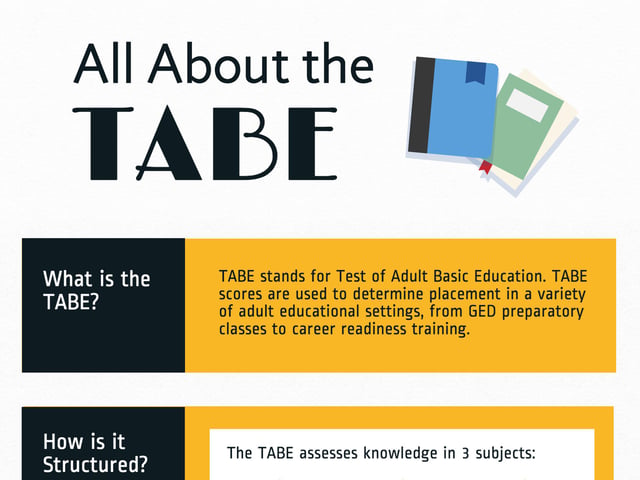
What is the TABE Test? Everything You Need to Know
Are you looking to develop your skills or acquire new ones?
After many years away, re-entering the study sphere can feel like a daunting task.
Many adult education programs and trade schools require students to take the TABE test. Success on the TABE can open doors of opportunity and help you move on to the next phase of your life.
Learn everything about the TABE test in this comprehensive guide.
What Is the TABE Test?
The TABE test determines a person’s baseline skills in specific academic subject areas. The acronym TABE stands for Test of Adult Basic Education.
The good news is you cannot fail the TABE. It is designed to test your academic strengths and identify areas for improvement.
The TABE caters to the education of adults who are hoping to start college, trade school, or technical school later in life. Based on your TABE scores, your prospective school will decide whether you are ready to tackle coursework or if you should wait until you are better prepared.
In this respect, the TABE is similar to the GED but not as hard. However, this does not mean the TABE is easy either.
The TABE assesses your skills in three subject areas:
-
Mathematics
-
Reading
-
English Language
Each subject area is in two sub-sections. For example, the English Language section of the TABE is in two parts: (1) Mechanics and Usage and (2) Paragraphs.
The first part tests your ability to properly use punctuation, capitalization, spelling, and correct word usage. In the second part, you will analyze a paragraph and decide how to organize it for more precise meaning.
You may have also noticed there are different TABE tests. There are currently four types of TABE tests:
-
TABE 11&12
-
TABE-PC
-
TABE-Advanced Levels
-
TABE Class-E
TABE 11&12 is the main version of the test that most students take. TABE-PC is a computerized version, while TABE Advanced Level is for students entering higher education. TABE Class-E is for students whose first language is not English.
Why Take the TABE Test?
The TABE test is a valuable tool in adult education. Many companies use it in hiring new employees. Schools also give the TABE test to ensure students have the basic skills to do well in school.
A person who struggles with math, reading, and language will find it challenging to complete an educational program, trade school, or a particular job. The TABE results can help you find a career path that will suit your level of learning and help you thrive in your role.
Many programs cater to students with different learning capabilities. The TABE test helps provide these institutions with a benchmark to monitor your progress. It also determines what work to give you to study.
Although you cannot pass or fail the TABE test, your score can impact your eligibility for many programs. As a result, it’s essential to prepare to take the test and give yourself the best opportunity to affect your life positively.
TABE Test Scores Explained
As you prepare for the TABE test, it’s crucial to understand how the scoring process works and how the results play a role in your education options.
The first difference between TABE and the GED is the TABE does not have a pass or fail score. You will also not lose any points for leaving questions blank. Your correct answers are added up based on the difficulty level of your TABE test.
There are five levels of difficulty on the TABE test:
-
Literacy
-
Easy
-
Medium
-
Difficult
-
Advanced
The TABE advanced level is ideal for adults who want to take GED and enter higher education.
Before the actual test, you will take a short “Locator” test to determine which level you should take. Depending on the result of the Locator, you may take different levels of the TABE in each of the three subjects.
TABE test results include different scores for each part of the test:
-
Raw score
-
Scale score
-
Grade equivalent score
The raw score indicates the number of correct answers. This number generates the scale score. The scale score compares your performance with the average test-taker at the same level and content area.
The scale score is between 0 and 999. If you get a 491 to 523, you have the same understanding of the content as a fourth to sixth-grade student.
The grade equivalent (GE) score is typically not interpreted for TABE. The reason is that the scores are not equivalent to different test levels.
As you prepare to take the test, check what TABE scores you need for acceptance into your specific program. You can use this as motivation to prepare well and score even better.
TABE Test Questions
The TABE test has a total of 195 multiple-choice questions. The questions are split into three learning sections, as mentioned earlier.
You have about three hours to complete the TABE test. The Locator test to determine your TABE level will take about an hour.
While we have touched on the Language section of the TABE, let’s look at the content sections in more detail.
Mathematics
The Mathematics section comprises two parts: (1) Applied and (2) Computation.
During the Applied section, you will need to solve word problems using a calculator. In the Computation section, you will be asked to perform basic arithmetic without a calculator.
Reading
The Reading section comprises two parts: (1) Evaluation and (2) Recall.
During the Evaluation section, you must think critically about words in a passage and determine their purpose. In the Recall section, you will be asked to understand the meaning of words in a reading passage and locate this information in graphic form.
English Language
The English Language section comprises two parts: (1) Mechanics and Usage and (2) Paragraphs.
During the Mechanics and Usage section, you will be tested on your ability to use the correct mechanics of proper English. In the Paragraphs section, you will analyze paragraphs and determine which sentences need to be deleted to make the paragraph more effective.
Benefits of Taking Practice Tests
They say that practice is perfect, right? Taking a practice test for the TABE can help you achieve better results. While you don’t have to take a practice test every day, you can take two to three leading up to your exam date.
Completing practice tests will help you to:
-
Build stamina
-
Track progress
-
Cement knowledge
-
Retain information
-
Reduce stress
-
Fill knowledge gaps
-
Practice timing
Practice tests are best used with other study materials such as flashcards and study guides. This will help you steer your learning in the right direction and practice what you need to score well.
Flashcards are an effective self-testing approach. They improve language skills, increase your recall abilities, and enrich your vocabulary.
Our free Flashcards for the TABE test will help you remember the terms and definitions involved in each content area. They are ideal for quick practice sessions when time isn’t on your side.
Preparing to Take the TABE Test?
If you’re re-entering a classroom for the first time in a while, taking the TABE test can seem daunting. The good news is it doesn’t have to be.
Taking the time to prepare will ensure you are confident enough to take the TABE and score well. Remember, there is no passing or failing grade.
Union Test Prep is your go-to for all things TABE test-related. We offer lessons, practice tests, flashcards, and study guides to help you pass the TABE test.
Get started with Union Test Prep today!
Keep Reading

Test for Adult Basic Education Blog
10 Tips to Increase Your TABE Test Score
Thanks to the Workforce Innovation and Opportunity Act, many people are…

Test for Adult Basic Education Blog
How to Pass the TABE Test
Adult learners add an average of $7,500 per year to their salaries just…

Test for Adult Basic Education Blog
The TABE: All About the Test
What is the TABE? TABE stands for Test of Adult Basic Education. TABE …